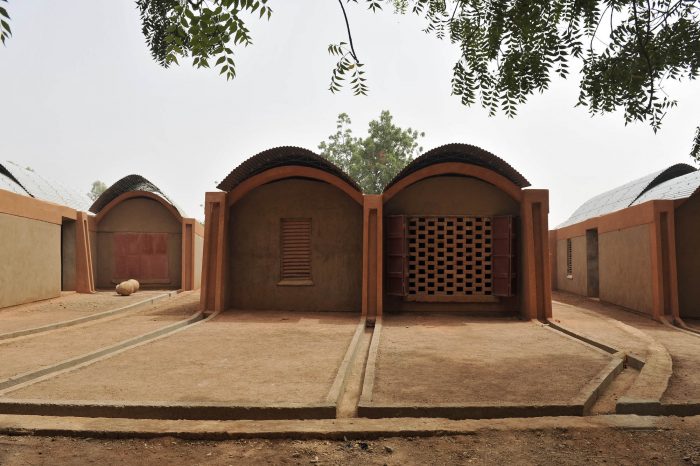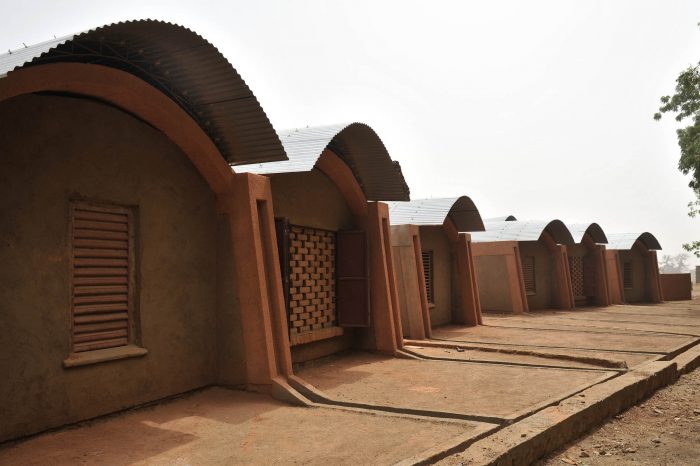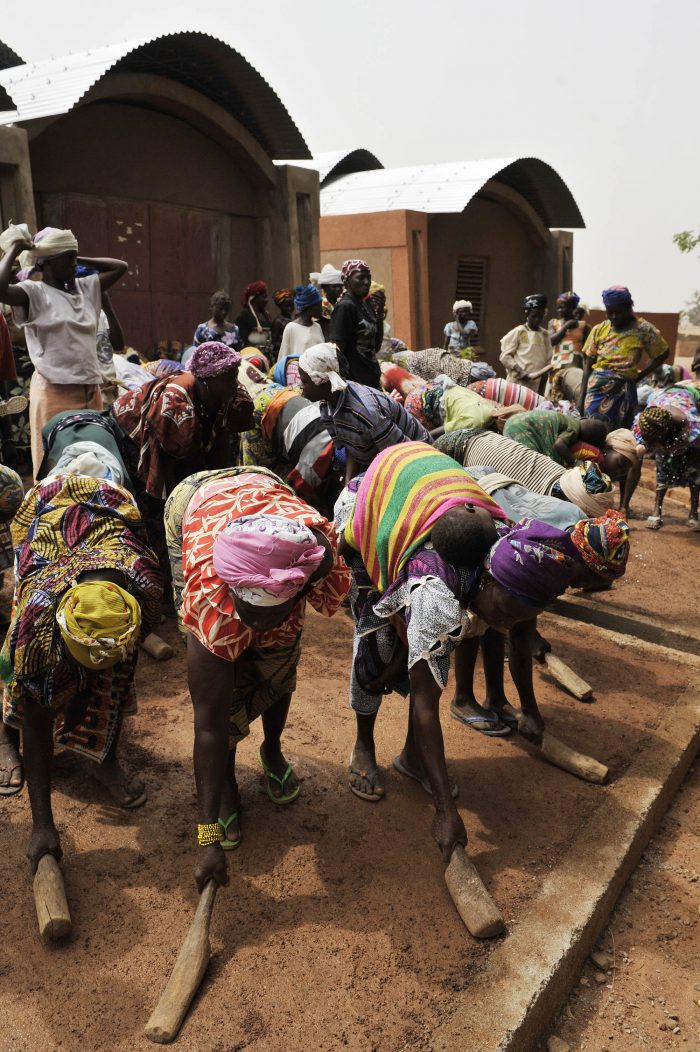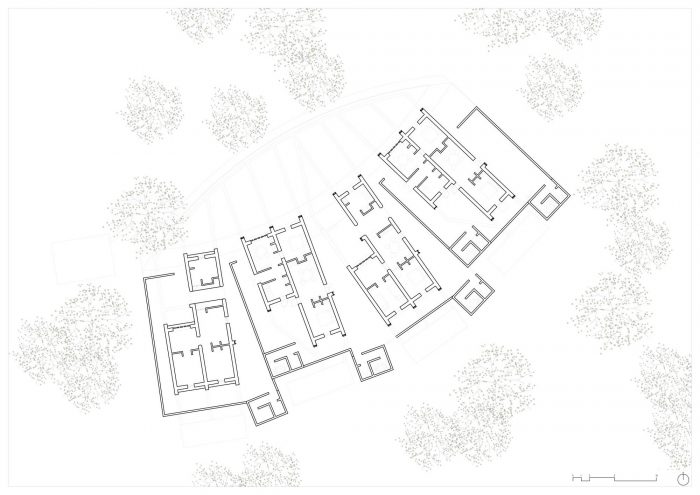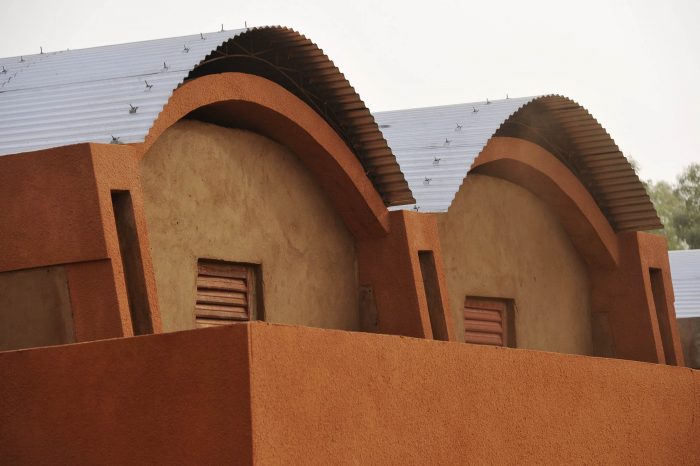教师住房的设计是为了吸引教师到农村去,并促进使用土作为一种可持续和耐用的建筑材料。这些房屋是由一系列可调整的模块组成的,每个模块的大小与该地区典型的传统圆形小屋相当。单个模块可以以各种方式组合成一个更大的复合整体。简单的设计和对购买材料的最少使用意味着它很容易被村民采用。六栋教师及其家属的房屋在学校综合楼的南面呈宽阔的弧形布置。这种弧形布局不仅美观,而且让人联想到传统的布基纳法索大院。屋顶是用稳定的土块建造的桶状拱顶。这种建筑方法在这一地区以前闻所未闻,利用了当地的资源,而且气候效率高。为了防止建筑受潮,40厘米厚的土坯墙立在就地浇筑的水泥和花岗岩石块基础上。村民们以每天600到1000块的速度生产了大约15000块,每块40x20x10cm。
The teachers’ houses were designed to attract teachers out to the countryside, as well as to promote the use of earth as a sustainable and durable building material. The houses were realized as a series of adaptable modules, each of comparable size to the traditional round huts typically found in this region. Single modules can be combined in various ways into a larger composite whole. The simplicity of the design and minimal use of bought materials means that it can easily be adopted by the villagers. The six houses for teachers and their families are arranged in a wide arc to the south of the school complex. This curvilinear layout is not only beautiful but is also reminiscent of a traditional Burkinabé compound. The roofs are barrel vaults constructed from stabilized earth blocks. This construction method, previously unheard of in this region, makes use of local resources and is climatically efficient. To protect the building from rising damp, the 40cm thick adobe walls stand on a foundation of cast in-situ cement and granite stones. The villagers produced around 15,000 blocks, each 40x20x10cm, at a rate of between 600 and 1,000 a day.
连接墙体的拉梁承担着每个模块的屋顶荷载。屋顶是一层钢筋混凝土,就地浇筑在压缩稳定土块(CSEBs)的永久性百叶窗上。屋顶高度在100厘米和150厘米之间交替,因此当它们重叠时,会形成一个镰刀形的开口,作为内部通风和提供日光的手段。宽大的屋檐可以保护墙壁不受潮。在传统的布基纳法索房屋中,一种特殊的薄壤土涂料–混合了蔬菜汁和牛粪–被涂在外墙,作为大约3厘米的保护层,以防止风化。
A tie beam connecting the walls bears the roof load in each module. The roof is a layer of reinforced concrete poured in situ into a permanent shuttering of compressed stabilized earth blocks (CSEBs). The roof heights alternate between 100cm and 150cm, therefore when they overlap a sickle-shaped opening is formed and serves as a means of ventilating the interior and providing daylight. Generous roof overhangs protect the walls from moisture. In traditional Burkinabé houses, a special type of thin loam rendering – mixed with vegetable juice and cow dung – is applied to the outer walls as a protective layer of about 3cm against weathering.
遗憾的是,这些成分在雨季没有什么用处,而且会引来白蚁,最终破坏墙壁。在教师住房中,传统的有机成分涂料被沥青取代。建筑工程的高潮是夯实粘土地面,形成光滑、均匀的表面。甘道人的热情参与是这个项目成功的关键。村民们不仅获得了新的技能,而且还获得了责任感、意识和对传统和创新建筑方面的敏感性。
Unfortunately these components are of little use in the rainy season and attract termites which can eventually destroy the walls. In the teachers’ housing, the traditional organic components of the rendering were replaced with bitumen. The culmination of the building work is the tamping of the clay floor to create a smooth, homogeneous surface. The enthusiastic involvement of the people of Gando was the key to the success of this project. The villagers gained not only new skills but also a sense of responsibility, awareness and sensitivity to both the traditional and the innovative aspects of building.
建筑师:Kéré Architecture
面积:930 m²
年份:2004年
摄影:Erik Jan Ouwerkerk
业主:Schulbausteine fuer Gando / Gando Village
国家:布基纳法索
Architects: Kéré Architecture
Area: 930 m²
Year: 2004
Photographs: Erik Jan Ouwerkerk
CLIENT:Schulbausteine fuer Gando / Gando Village Community
Country:Burkina Faso


